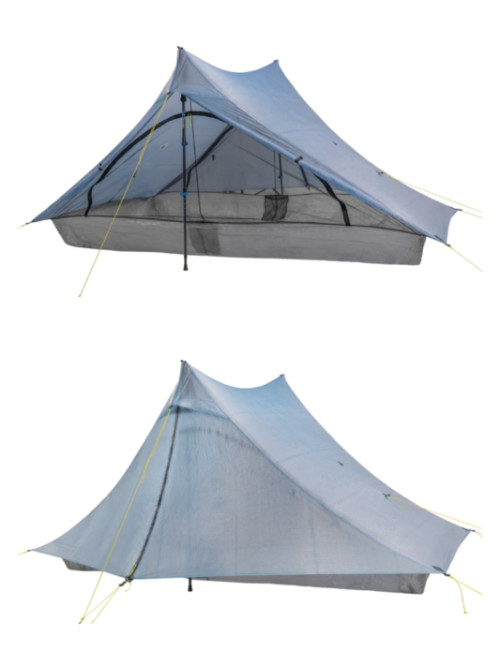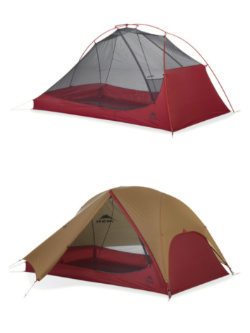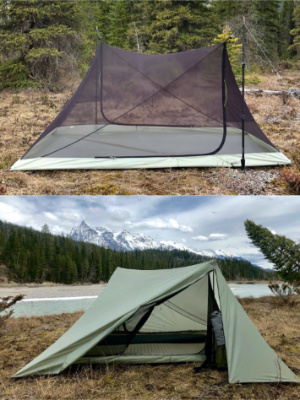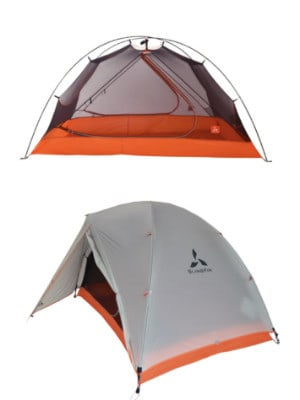PROTECT YOUR DNA WITH QUANTUM TECHNOLOGY
Orgo-Life the new way to the future Advertising by Adpathway
The best two-person backpacking tents weigh three pounds or less. Since you have to carry your tent when backpacking, weight is a very important consideration, but there are others as well, including: cost, the number of doors and vestibules, its dimensions, whether the interior stays dry when set up in the rain, and whether the fabric stretches when it gets wet, among others. Weighing these different factors, here are our recommendations for the best two-person backpacking tents. While everyone’s priorities are different, we feel that these two-person backpacking tents provide the best balance of features and cost available today.
1. Big Agnes Copper Spur UL 2

The Big Agnes Copper Spur UL2 is the most popular two-person backpacking tent, and with good reason. This freestanding tent is easy to set up and has two doors so you can get in and out without having to crawl over your companion at night. It has a spacious interior with lots of headroom and vertical sidewalls so you can change clothes and sit up inside without touching the sides. Awning-style vestibules expand the covered living space, which is great for both drizzle and sun protection, while two-way door zippers let you vent warm air without compromising privacy. Off-the-floor storage in the form of an oversized ceiling pocket in the head, side pockets, and media pockets provides plenty of space for personal items you want close at hand. Weighing just 2 lbs 10 oz, the Copper Spur is an exceptionally lightweight but fully featured backpacking palace.
2. NEMO Dagger OSMO 2 Tent

The NEMO Dagger OSMO 2P Tent is a spacious freestanding double-wall tent for two people with two doors and two vestibules. Weighing 3 lbs 5 oz, the tent is made with NEMO’s OSMO polyester/nylon ripstop fabric, which reduces rain fly sag when wet and improves waterproofing. The spacious interior and numerous livability accents make the Dagger OSMO 2P a great tent for tall people or couples who want more room to spread out. Read the SectionHiker Dagger OSMO 2 Review.
3. Zpacks.com Duplex Zip Tent

The Zpacks Duplex Zip is a single-wall trekking pole tent that only weighs 19.0 ounces. It has ample space for one person plus gear but can also fit two people comfortably. It has two doors so you get good ventilation and vestibule space on both sides of the tent but you can zipper the doors closed for increased wind protection and stability. The Duplex Zip has a full bathtub floor, taped seams, and mesh sidewalls for insect protection. Pitching the symmetrical tent structure requires two trekking poles, but the dual apex structure is quite strong and wind-resistant. The Duplex is made with an ultralight waterproof material called Dyneema Composite Fabric, which is waterproof and won’t sag at night or when it rains. It is translucent, however, which can compromise your privacy when camping near others. Read the SectionHiker Duplex Zip Review.
4. MSR Hubba Hubba LT 2P

The new MSR Hubba Hubba 2 is a lightweight freestanding two-person backpacking tent weighing 3 lbs and provides lightweight livability, superb ventilation, and ease of use. The latest version of the Hubba Hubba 2 has a rectangular floor plan (a rare feature), provides ease of use, and has a premium feature set including a unified hub-and-pole system, corner and overhead gear pockets, large vestibules, and kickstand vents. Read the SectionHiker Hubba Hubba Review.
5. Gossamer Gear “The Two” Tent

Gossamer Gear’s “The Two” Tent is a single-wall trekking pole tent with two doors and two spacious vestibules. While it’s made by a smaller gear company, it’s very well built, with fully taped seams, excellent waterproofing, great headroom and length for taller campers, interior clotheslines, and gear pockets that make it a joy to use. Weighing just 23.5 oz, it’s also really lightweight and packs up small (11″ x 5″) in part because you use two trekking poles to set it up (tent poles are available separately). The Two is a great tent for warmer weather in milder conditions and is still quite affordable. Read the SectionHiker “The Two” Tent Review.
6. MSR Freelite 2

The MSR Freelite 2 is a 32 oz two-person tent with two doors and two vestibules. It has a true rectangular floor, 50 inches wide, without a foot taper like most other two-person tents. A unified hub-and-pole system and symmetrical design make setup super quick. Inside, tech-friendly pockets feature cable ports at the corners for headphone and charging cords, while the overhead gear loft pockets are perfect for headlamps, sunglasses, and other quick-access items. Read the SectionHiker Freelite 2 Tent Review.
7. Tarptent Double Rainbow Tent

The Tarptent Double Rainbow is a single-wall, two-person tent that weighs 2 lbs 10 oz. It has two side doors and two large vestibules for gear storage. Constructed as a single unit, the tent requires a single tent pole, which is inserted into a long-sleeve sewn onto the top of the tent. Trekking poles can also be used instead of tent stakes, to stretch out the tent corners and make the tent freestanding, for use on wooden platforms or rock ledges. The tent has a bathtub floor to prevent rain from entering the tent as well as large mesh sidewalls. Roof vents also help vent moisture and prevent internal condensation. This tent is very popular with lightweight backpackers and provides excellent value for the price. Read the SectionHiker Review.
8. Durston X-Mid-2

The Durston Gear X-Mid 2 is a spacious double-wall, two-person trekking pole tent that requires two trekking poles to set up. Weighing 36 oz, the tent has two doors and two vestibules with a shape that makes it extremely weather and storm-worthy. The all-mesh interior tent has offset peaks to maximize headroom and comes with four interior pockets for gear storage. Large kickstand vents in the fly provide excellent ventilation, but the dual doors and vestibules are also designed so they can be left open in the rain without splashback. The tent is made with no-sag polyester and fully seam-taped with Aquaguard door zippers enabling hassle-free use in all conditions. An ultralight Dyneema DCF version is also available.
9. SlingFin Portal 2

The Slingfin Portal is a lightweight two-person tent that can be used year-round in more extreme weather (Slingfin was founded by Martin Zematis, the guy who started Mountain Hardware). Weighing just 2 lbs 13 oz, it has a unique internal guyline system that adds superb wind resistance without additional weight. Two large vestibules and numerous internal pockets provide best-in-class livability, while its freestanding, dome-shaped exoskeleton makes it easy to set up. Kickstand door vents provide unrestricted cross-tent airflow for excellent condensation management without sacrificing weather protection. Read the SectionHiker SlingFin Portal Review.
10. NEMO Dragonfly OSMO 2 Tent

The NEMO DragonFly OSMO 2 is a lightweight freestanding two-person tent with two doors and two oversized vestibules that provide ample storage for backpacks and wet hiking boots. Weighing 2 lbs 10 oz, the tent is made with NEMO’s new OSMO polyester/nylon ripstop fabric which reduces rain fly sag when wet and improves waterproofing. The tent’s exoskeleton architecture comes with prebent tent poles that maximize head and shoulder space, providing plenty of room inside to change clothes or sit out rainy weather, while large D-shaped doors make it easy to enter and exit the tent and can also be rolled back in hot weather for extra ventilation. Overhead light pockets at both ends use special light-diffusing fabric to cast an even glow throughout the tent while interior gear pockets in the corners offer occupants ample storage for personal items. Read the SectionHiker DragonFly 2 Review.
Tent Evaluation Criteria
Here are the most important variables to consider when buying a backpacking or camping tent.
Total Weight/Trail Weight
The total weight of a tent usually measures the tent and all of its packaging, while the trail weight is the weight of its poles, inner tent, outer rain fly, minus any tent stakes. Why the difference? Most people replace the tent stakes that come with a tent with lighter weight or stronger ones and leave all the extra stuff sacks and packaging at home rather than carry it.
Tent Poles
Tent poles are made using fiberglass, aluminum, or carbon fiber. Aluminum is the most durable of the three, while carbon fiber is normally only used in very high-end tents where the focus is on light weight. Fiberglass poles are the least durable tent poles and break frequently. So much so, that we recommend avoiding any tent with fiberglass poles. All the ones above have aluminum poles or use trekking poles. Most manufacturers who sell trekking pole tents offer regular tent poles as an add-on purchase.
Trekking pole tents are quite strong and wind-resistant as long as your trekking poles are in good working order. They’re a good option if gear weight is your chief concern.
Durability
The floor of a tent is the part of a tent most likely to be punctured or torn as a result of ground abrasion. While using a footprint on floors that are 20 denier thick or less is always recommended, it’s far less necessary on 30 denier or higher floors, except on highly abrasive or rough terrain.
Number of Doors
Tents with two side doors are often preferable when purchasing a tent for two because it means each occupant can get in and out without disturbing one another. One-person tents with two doors are also quite convenient, especially in bad weather, since you can cook under one vestibule and store gear in the second.
Interior Storage
Interior pockets and storage organization are a plus in a multi-person tent. Look for internal pockets and gear loops to hang gear from the ceiling. A gear loft is an added bonus. Vestibule space is always a plus as well, but especially if there are multiple doors so that gear storage does not block entry and exit.
Ventilation
All tents experience tent condensation, but good tent site selection and ventilation are the best ways to avoid it. Look for tents that have lots of mesh netting to facilitate airflow, top vents to release moist air, and door tie-backs to roll up tent doors and keep them open at night.
Frequently Asked Questions
1. What is the best two-person backpacking tent??
It depends on your needs; popular models include the Big Agnes Copper Spur, MSR Hubba Hubba NX, and Nemo Hornet.).
2. How much does a typical two-person backpacking tent weigh?
Usually between 3 to 5 pounds (1.4 to 2.3 kg).
3. Are two-person backpacking tents suitable for solo camping?
Yes, they offer extra space for gear and comfort.
4. What is the average price range for a good two-person backpacking tent?
Between $200 and $500, with ultralight models costing more.
5. How durable are two-person backpacking tents?
They are designed to be durable but may have lighter materials to reduce weight.
6. Can two-person tents fit two people comfortably?
Yes, but comfort depends on the tent’s size and design.
7. What are the most popular brands for two-person backpacking tents?
Big Agnes, MSR, Nemo, REI, and Hilleberg.
8. How easy is it to set up a two-person backpacking tent?
Most modern tents are designed for quick and straightforward setup.
9. What materials are used in two-person backpacking tents?
Lightweight nylon or polyester fabrics with aluminum or carbon fiber poles.
10. Are two-person tents waterproof?
Most have waterproof rainflies and floors, but quality varies.
Features & Specifications
11. What is the difference between freestanding and non-freestanding two-person tents?
Freestanding tents use poles to hold their shape without stakes; non-freestanding tents require staking.
12. How important is tent ventilation in a two-person tent?
Very important to reduce condensation and maintain airflow.
13. What is the best season rating for a two-person backpacking tent?
Three-season tents suit most conditions; four-season are for extreme weather.
14. How much headroom do two-person tents usually offer?
Typically 3 to 4 feet of peak height.
15. Do two-person tents have vestibules or storage space?
Many have vestibules for gear storage outside the sleeping area.
16. Are there two-door options for these tents?
Yes, some models have two doors for convenience.
17. What is the floor area of standard two-person tents?
Usually between 30 to 40 square feet (2.8 to 3.7 m²).
18. Are two-person backpacking tents suitable for extreme weather?
Some four-season models are; most three-season tents are not.
19. What kind of tent stakes are best for backpacking tents?
Lightweight aluminum or titanium stakes.
20. How important is the tent pole material?
Very; aluminum poles balance weight and strength well.
Usage & Practicality
21. Can you fit gear inside a two-person backpacking tent with two people?
Usually limited, vestibules are often used for gear storage.
22. How do you keep a two-person tent dry in heavy rain?
Use a rainfly, proper staking, and pitch on high ground.
23. Are two-person tents good for winter camping?
Only if rated for four seasons; otherwise, they may not handle snow or wind well.
24. How well do two-person tents handle wind?
Depends on the design; dome shapes handle wind better than tunnel shapes.
25. Can you pitch a two-person tent solo easily?
Yes, but it may take more time than with one person helping.
26. How compact do two-person backpacking tents pack down?
Usually between 10 and 20 liters in volume.
27. Are two-person tents good for backpacking with pets?
Yes, but size and ventilation should be considered.
28. Can you use a tarp with a two-person backpacking tent for extra coverage?
Yes, many campers use tarps as additional shelter.
29. How do you clean and maintain a two-person backpacking tent?
Clean with mild soap and water; dry fully before storage; repair small tears promptly.
30. Can you repair tears or damage on a backpacking tent?
Yes, with repair patches or sewing kits designed for tents.
Comparison & Buying Advice
31. Should I buy a three-season or four-season two-person tent?
Choose based on when and where you’ll camp; three-season for most conditions, four-season for snow and cold.
32. Is it better to have a lighter tent or more durable tent for backpacking?
It depends on your priorities: lighter tents save weight but may sacrifice some durability.
33. What size sleeping bags fit best in a two-person tent?
Regular or mummy bags sized for your height; consider width if sharing space.
34. How does a two-person tent compare to a hammock tent for backpacking?
Tents offer more protection from elements; hammocks can be lighter but need suitable trees.
35. Are double-wall or single-wall two-person tents better for backpacking?
Double-wall offers better condensation control; single-wall is lighter but may have more condensation.
36. What factors should I consider when choosing a two-person backpacking tent?
Weight, durability, season rating, ease of setup, ventilation, and price.
37. Do I need a footprint with my two-person tent?
It helps protect the floor and extend the tent’s life but is not always necessary.
38. Can I use my regular camping tent for backpacking instead of a specialized one?
You can, but specialized backpacking tents are lighter and more compact.
39. Are there eco-friendly or sustainable options for backpacking tents?
Some brands offer tents made from recycled materials or use environmentally friendly processes.
40. What are the best budget-friendly options for two-person backpacking tents?
REI Co-op Half Dome SL and Kelty Salida are good affordable choices.
Specific Situations & Extras
41. Can I use a two-person tent in cold, snowy conditions safely?
Only if it’s a four-season model designed for snow load and wind resistance.
42. How do I increase ventilation in humid conditions with these tents?
Open mesh panels or vents, and avoid sealing the tent completely closed.
43. Are mesh panels useful in preventing bugs in two-person tents?
Yes, mesh panels keep insects out while allowing airflow.
44, Is it better to have a tent with an integrated rainfly or a separate one?
Separate rainflies offer better versatility and drying options; integrated flys are simpler but less flexible.
45. Can I add an awning or extra shelter to a two-person backpacking tent?
Some models allow attachments or use of tarps to extend shelter area.
46. How do I store my tent properly when not in use?
Store loosely in a cool, dry place; avoid compressing it long term to preserve materials.
47. Are there ultralight options under 3 pounds for two-person tents?
Yes, some ultralight models like the Zpacks Duplex weigh under 3 pounds but cost more.
48. Do any models offer quick setup or pop-up features?
A few do, but most ultralight backpacking tents focus on weight over speed of setup.
49. How do I choose between synthetic and natural fabrics in tents?
Most tents use synthetic fabrics (nylon/polyester) because they’re lightweight and water-resistant; natural fabrics aren’t common in backpacking tents.
50. Can I use trekking poles to pitch a two-person backpacking tent?
Yes, some tents are designed specifically to use trekking poles instead of traditional poles to save weight.
SectionHiker never accepts payment for gear reviews or editorial coverage. When you buy through affiliate links on our site, we may earn a small commission at no extra cost to you. Help us continue to test and write unsponsored and independent gear reviews, hiking and backpacking FAQs, and free hiking guides.



















 English (US) ·
English (US) ·  French (CA) ·
French (CA) ·